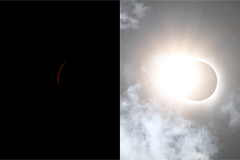
Mabank, Texas
4:06 Totality
About
After seeing the 2017 eclipse from Columbia SC, there was no way I was going to miss one that had twice the totality and was in the US. And given that the next eclipse in the lower forty eight will not be for another 20 years, this one was not to miss.
Given all the information that was available back in May 2023 when the trip was planned, it was decided to go to Mabank Texas which is near the most Texas named city of all time "Gun Barrel City". All of which is to say we were about 1.5 hours South East of Dallas. With the best chance for clear skies in April and a predicted totality of 4:06 all that could be done was to hope and wait.
We got a fine little VRBO on a lake and had a group of 13 people to share in the experience which was simply incredible. I was wondering if it would lose any of its amazement the second time but a Total Solar Eclipse is just one of the most phenomenal experiences you can witness. No, pictures just don't do it justice. No, a 99.9% partial eclipse is nothing like a 100% total eclipse. If you have any doubts, simply talk to anyone that has ever witnessed the real deal.
We were all worried in the days before as a major storm front was moving into Texas and all of the weather predictions were dire. The day of the eclipse we did have clouds during the partial phases but about 15 minutes before totality we got clear skies and wonderful views which lasted the entire totality.
This trip I really wanted to up my photography game from the last time and I was very happy with the results. I definitely needed the practice and learning the weeks before and some new equipment like a better tripod and mount didn't hurt. It's always a difficult juggling act to balance taking the time to get some photos with simply enjoying the experience in the moment. If you plan on seeing an eclipse and taking some photos the best advice I can give is to practice multiple times before the event. The time during totality will fly by so fast you will not believe it's over so quick.
Some of the Best
Stacked Image. Multiple images combined into a single HDR image.

The "Diamond Ring" a second or two before totality.

Exposures at different shutter speeds. Combine these three pictures to create the stacked image above.
 1/800 Second |
 1/40 Second |
 1/2 Second |
People
What is a trip without some great friends to share it with?
 |
 |
 |
 |
 |
 |
Image Processing
In researching how to combine images I found two major methods involving Photoshop. While the Mean Blend Method gives a soft and pleasing appearance I found it too soft for my taste and I preferred the more simple stack and change opacity. What really sets this method above was when I found and started to use the "High Pass' filter on the layers to really bring out the corona.

Partials
Not a lot to say about these. We had clouds move in and our during the before and after partial phases so I'm not going to get any interesting set of progression pictures, but this is what I got.
 |
 |
 |
99.9% vs 100%
Many times when you talk to people about a total eclipse they will reply with something along the lines of "Well I saw it at 80% and I'm sure it was almost as good". Nope, No it is not. Below are 2 pictures taken almost at the same moment. In the first a solar filter is blocking the sun and the second no filter. These pictures show what a 99.9% Total eclipse is and it's just not the same thing. The sun is simply that bright.

Cell Phone and Telescope
Something that I was not able to do the last eclipse was to capture any images of what I was seeing in the small telescope that I have. Before this eclipse I did some testing with some methods to connect my camera to the telescope but I was just not happy with the results finding them a bit soft. Looking online I did see a couple of products that allow you to attach a cell phone so that it can take a picture through the eyepiece which I was hoping would be a find substitute, but alas no.
On the left is image taken with the cell phone looking through the telescope with a 32mm filter giving about a 12x magnification. On the right is the image through the camera with a 250mm telephoto lens. Crazy but you get more magnification and clarity from the camera and a basic 250mm zoom.

Andy's Photos
My friend Andy got some great shots as well but his truly outstanding image is the one he got right before totality ended and where he captured an incredible view of a solar prominence. Hats off to this image.

